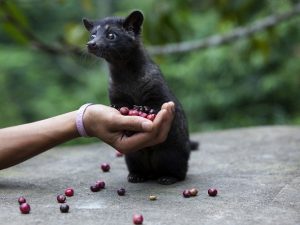The most expensive coffee comes from what?

Kopi Luwak coffee will run you somewhere in the range of $35 to $100 for a single cup. Expensive yes, but what’s even more shocking is when you find out Kopi Luwak is actually made from cat poop. The feces comes from the Asian palm civet, a species of cat native to Southeast Asia and sub-Saharan Africa. This is why the coffee is called Kopi Luwak, “Kopi” is the Indonesian word for coffee and “luwak” is what the Asian palm civet is called in Sumatra, an Indonesian island in Southeast Asia.

One of the reasons the price tag is so high for this coffee is the rare method by which it is produced. The palm civet eats ripe coffee cherries and digests them for over 24 hours during which enzymes break down the beans’ protein, changing the taste and chemical composition of the beans. The undigested beans are excreted in the palm civets’ poop, from then they are collected, washed, dried, roasted, ground and brewed for us to consume.
Why would anyone pay that much for a cup of coffee that comes from poop? Well, coffee fanatics claim Kopi Luwak has a superior taste, which is best described as a chocolaty flavor, musty tone and nutty aftertaste. They say this is because wild palm civets forage for the ripest coffee cherries, which in turn produce better coffee. Furthermore, the digestion process produces a unique taste which cannot be replicated. The taste, along with the low supply, high demand and the bizarre production method, create an expensive and unique product.
If you decide to try this costly cup of coffee, be on the lookout for fake Kopi Luwak and caged palm civet farms. About 70% of Kopi Luwak coffee that is available in stores and on the internet is not 100% pure Kopi Luwak, and sometimes does not contain any at all. Although there is no tell-tale way to identify fake Kopi Luwak, avoid buying wholesale packages and low-cost Kopi Luwak. Secondly, due to the high demand for this product, farms are often overcrowded and utilize poor and unhealthy  practices while caring for the animals. Often hundreds of the palm civets are caged together where they will fight or gnaw on their own limbs due to mental distress. Furthermore, caged palm civets are given coffee cherries to eat rather than selecting their own cherries where they would only choose the ripest.
practices while caring for the animals. Often hundreds of the palm civets are caged together where they will fight or gnaw on their own limbs due to mental distress. Furthermore, caged palm civets are given coffee cherries to eat rather than selecting their own cherries where they would only choose the ripest.
Kopi Luwak is certainly unique and arguably delicious and might be on your bucket list to try, but I’m not sure this will be coming to a coffee shop near you anytime soon!
Works cited:
http://coffeeroastersdirect.com/tips-to-differentiate-real-or-fake-kopi-luwak/